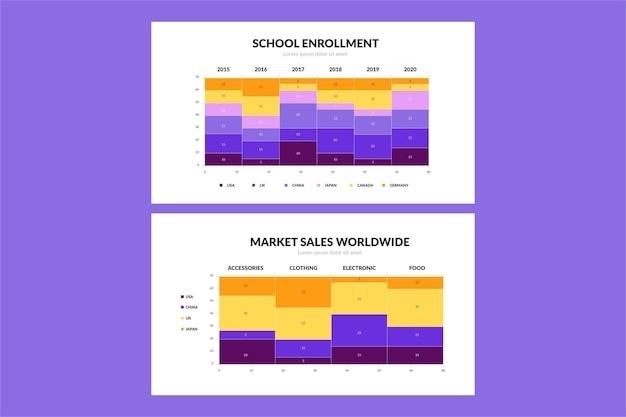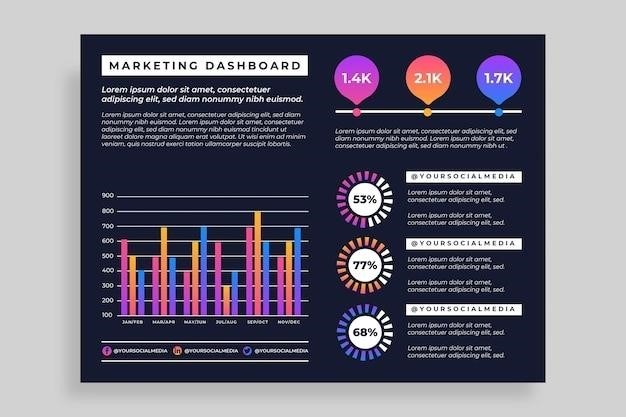Pitching Chart PDFs⁚ A Comprehensive Guide
This guide explores the world of pitching chart PDFs, offering insights into their various types, benefits for coaches and players, and resources for downloading or creating custom charts. Learn how to track pitch types, locations, and counts effectively for performance analysis and improvement. Free downloadable templates are also highlighted.
Types of Pitching Charts
Pitching charts come in various formats, each designed to meet specific needs. Simple charts might track basic pitch type and location (e.g., inside/outside, high/low), while more advanced versions incorporate detailed strike/ball counts, pitch velocities, and even batter-specific data. Some charts focus solely on pitch location, using a visual grid to represent the strike zone and the placement of each pitch. Others integrate additional information like pitch sequences, results (strikeout, hit, etc.), and even the batter’s tendencies. Coaches might prefer comprehensive charts offering a holistic view of a pitcher’s performance, while individual players may find simpler, more focused charts easier to use for self-assessment. The choice depends on the level of detail required and the specific goals of tracking the pitching data. Digital versions offer advantages like easy data entry, analysis, and sharing, while printed PDFs provide a tangible record for immediate on-field review. The versatility of these charts allows for customization to suit any team or individual’s preferences and analytical needs. Consider factors like ease of use, data accessibility, and the depth of information needed when selecting a pitching chart type.
Free Downloadable Pitching Chart PDFs
Numerous websites offer free downloadable pitching chart PDFs, providing readily available tools for coaches and players. These resources often come in various formats, including simple templates and more complex, detailed charts. Some websites specialize in sports-related resources, offering a selection of free printable charts that can be customized to meet specific needs. Others might offer pitching charts as part of a larger collection of coaching tools or training materials. These free PDFs often allow for easy printing and manual data entry, making them convenient for use during games or practices. However, the functionality of free charts might be limited compared to paid software or advanced digital solutions. While free options eliminate financial barriers, users should carefully consider the chart’s features and ensure it aligns with their data tracking requirements. The availability of free downloadable pitching chart PDFs significantly expands access to valuable tools for performance analysis and improvement within the baseball community.
Features of Effective Pitching Charts
Effective pitching chart PDFs incorporate several key features to maximize their utility. Clear and concise organization is paramount, ensuring easy data entry and retrieval. A well-designed chart uses visual cues effectively, such as color-coding or symbols, to represent different pitch types or locations. Sufficient space for recording relevant information, including pitch type, location (e.g., using a grid system), result (ball, strike, hit), and batter information, is essential. The ability to track pitch counts is a crucial element of effective charts, helping monitor a pitcher’s workload and prevent injury. Some advanced charts may incorporate sections for recording additional data, such as pitch velocity, movement, or the type of swing used by the batter. A simple, intuitive layout minimizes confusion and ensures quick data entry during fast-paced games. Finally, the ability to easily customize or adapt the chart to specific needs or preferences further enhances its effectiveness. These features collectively contribute to a comprehensive and user-friendly tool for analyzing pitching performance.
Using Pitching Charts to Track Pitch Types and Locations
Pitching charts are invaluable tools for meticulously tracking pitch types and locations. A typical chart uses a grid representing the strike zone, allowing for precise plotting of each pitch. Different symbols or abbreviations can represent each pitch type (e.g., FB for fastball, CB for curveball, SL for slider). The location within the strike zone grid is marked for every pitch thrown, providing a visual representation of the pitcher’s command and tendencies; This detailed record reveals patterns and potential weaknesses, highlighting areas where the pitcher consistently misses the strike zone or relies too heavily on certain pitches. By visualizing this data, coaches and players can identify areas needing improvement in pitch control and placement. The information gathered aids in strategic adjustments during games and tailored practice plans to hone pitching accuracy and effectiveness. Over time, the accumulation of data from multiple games or sessions provides a comprehensive overview of a pitcher’s development and progress.
Analyzing Pitching Performance with Charts
Analyzing pitching performance using charts involves more than just recording pitch locations and types. Effective analysis requires a deeper dive into the data to uncover meaningful trends. For example, examining the distribution of pitches across the strike zone can reveal tendencies, such as a reliance on the outside corner or an inability to consistently command the inside corner. Comparing pitch effectiveness based on location, coupled with the outcome (strike, ball, hit), reveals which areas are most successful and which are vulnerable. Analyzing pitch sequences can shed light on the pitcher’s approach and how batters react to different combinations. This detailed analysis helps to identify strengths and weaknesses, informing adjustments in pitch selection, location, and sequencing. Furthermore, comparing performance across multiple games or seasons reveals improvements or areas needing sustained attention. By integrating these analytical techniques with the visual representation provided by the chart, a comprehensive understanding of a pitcher’s performance emerges, guiding training and strategic decisions.

Benefits of Using Pitching Charts for Coaches and Players
Pitching charts offer numerous benefits for both coaches and players. For coaches, charts provide a visual record of a pitcher’s performance, easily highlighting strengths and weaknesses. This allows for targeted training and adjustments to pitching strategies. By analyzing pitch location and effectiveness, coaches can identify patterns and tendencies, guiding the pitcher towards improved command and control. Charts also facilitate communication between coach and player, providing a common ground for discussing performance and setting goals. For players, charts offer self-awareness and insight into their pitching mechanics and effectiveness. Tracking pitch location and results enables players to identify areas needing improvement, promoting targeted practice and skill refinement. The visual representation of performance can also boost confidence as players see tangible evidence of their progress. Regular use of pitching charts fosters a data-driven approach to improvement, encouraging self-reflection and a more strategic approach to the game. The ability to track pitch counts is also crucial for managing workload and preventing injury.

Pitching Chart Templates⁚ Formats and Customization
Pitching chart templates come in various formats, readily available for download in PDF, Word, or other editable file types. These templates offer a structured framework for recording pitch data, typically including sections for pitch type, location, result (strike, ball, hit), and often a running pitch count. The level of detail can vary, with some charts providing simpler grids for basic data recording, while others incorporate more advanced features like zones for pitch location, or spaces for additional notes. Customization is key. Many templates allow for personalization, enabling users to adjust the layout, add team logos, or tailor the categories tracked to fit specific needs. Some offer pre-defined pitch types, while others provide blank spaces for users to list individual pitches. The flexibility of these templates is a significant advantage, catering to different levels of play, from youth leagues to professional organizations. Choosing a template depends on the desired level of detail and the specific data points to be tracked. The ability to customize ensures the chart effectively meets individual or team needs, maximizing its utility for analysis and improvement.
Tracking Pitch Counts and Innings Pitched
Accurate pitch count tracking is crucial for managing pitcher workload and preventing injuries. Pitching chart PDFs provide a dedicated space to meticulously record each pitch thrown during a game or practice session. This detailed record allows coaches and trainers to monitor a pitcher’s total pitch count, providing insights into their overall effort and potential fatigue. Beyond the total count, many charts offer a breakdown by pitch type, revealing the frequency of different pitches used. This data is vital for assessing a pitcher’s pitch mix and identifying areas for strategic adjustments. Furthermore, effective charts will include a section dedicated to tracking innings pitched, offering a broader perspective on a pitcher’s performance and workload over a longer period. This combined data – pitch count and innings pitched – is essential for creating effective pitching plans and managing a pitcher’s long-term health and performance. The visual representation of this information in a well-designed PDF allows for quick and efficient assessment, aiding in informed decision-making regarding pitching strategy and pitcher well-being.
Advanced Pitching Chart Analysis Techniques
Beyond basic pitch count and location tracking, advanced analysis of pitching chart PDFs can unlock deeper insights into pitcher performance. By categorizing pitches not only by type but also by their effectiveness (e.g., strikes, balls, hits), a more nuanced understanding of a pitcher’s strengths and weaknesses emerges. Analyzing pitch sequencing reveals patterns and tendencies, allowing coaches to identify optimal pitch combinations and exploit hitter weaknesses. Comparing charts across multiple games reveals trends in performance over time, highlighting areas of improvement or regression. Integrating data from other sources, such as scouting reports or video analysis, enhances the accuracy and depth of the analysis. Advanced techniques involve using statistical methods to calculate metrics such as strike percentage, first-pitch strike rate, and batting average on balls in play (BABIP) for each pitch type. Software tools can automate data entry and calculations, generating visual representations of performance trends. This advanced analysis empowers coaches to make data-driven decisions, optimize pitching strategies, and maximize a pitcher’s potential. The insights gathered significantly contribute to the development and success of both individual pitchers and the team as a whole.
Resources for Downloading and Creating Pitching Charts
Numerous online resources provide free downloadable pitching chart PDFs in various formats, catering to different needs and preferences. Websites specializing in sports templates often offer customizable options, allowing coaches to modify chart layouts, add team logos, or incorporate specific data points. Some platforms provide interactive charts, enabling real-time data entry and analysis during games. Software applications dedicated to baseball statistics and analysis offer more advanced features, including data import/export capabilities, statistical calculations, and visual data representation. For those seeking greater control over chart design, spreadsheet programs like Microsoft Excel or Google Sheets allow for the creation of custom charts from scratch, offering flexibility in layout and data fields. Additionally, numerous online tutorials and guides provide step-by-step instructions for creating effective and efficient pitching charts, ensuring that even those with limited design experience can generate useful tools for performance tracking and analysis. Remember to always check the source for reliability and accuracy before using any downloaded templates or software. Consider factors like ease of use, customization options, and compatibility with your devices and software when choosing your resources.


